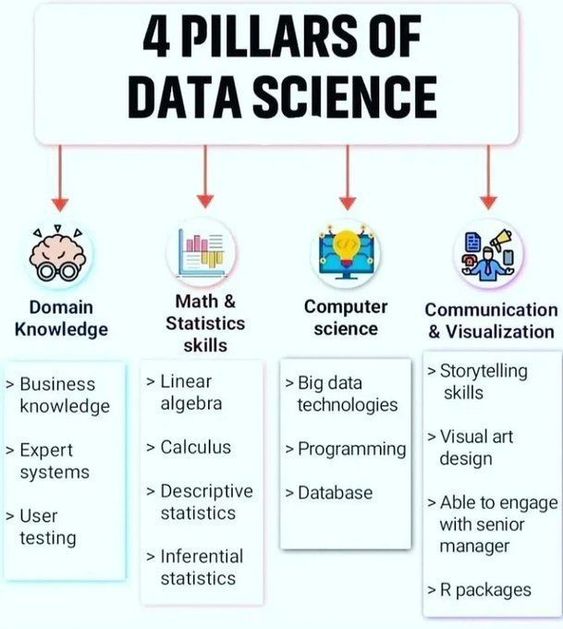
Data science is an interesting field that combines domain knowledge, math and statistic skills, computer science and communication & visualization. Let me explain each of these pillars with some examples:
Domain Knowledge
Domain knowledge is the most important pillar of data science. It’s the understanding of the problem domain, which can be anything from medicine to finance to retail. Domain knowledge is the foundation for all data science work and forms a basis for other pillars (e.g., algorithms and statistical techniques). A good example of domain knowledge would be knowing how many customers bought something at an online store in a given month, because this information may indicate whether or not your business should hire more employees or buy more inventory in order to meet demand during high traffic periods like Black Friday sales season.
Math & Statistic Skills
The math and statistics you need to know depends on the problem you’re solving. There are many different types of math and statistics, but you only need to know the basics. Algebra: In data science, algebra is used for simple calculations such as determining whether a given number is greater than another number or calculating an average value from a set of numbers. You might also use algebra when working with probabilities (a probability distribution). For example, if there’s a 50% chance that it will rain tomorrow and an 80% chance that it won’t rain tomorrow–what is our overall forecast? If we have two events happening independently of each other (such that one doesn’t affect the other), then their joint probability equals their individual probabilities multiplied together–so here this would mean: P(rain) x P(no rain) = 0.5 x 0.8 = 0.4 (or 40%). This means if we add all these probabilities together then they should sum up to 100%.
Computer Science
Computer science skills are essential for data science. You don’t need to be a programmer, but you do need to understand how computers work. You don’t need to know how to code in order to be a good data scientist, but if you want an edge over other candidates, learning some programming languages will help your cause significantly. The most common languages used by data scientists are Python and R (and sometimes SQL), so those are good places to start if you’re new at this game! In addition to knowing about computer science fundamentals like algorithms and software engineering principles like object-oriented programming (OOP), there are also specific concepts related to storing and processing large amounts of data that every aspiring data scientist should know about before embarking on their career path:
Communication & Visualization
Visualization is an important part of data science, because it’s how you communicate insights and help others understand what the data means. Visualization can be used in many ways. To understand the data better. Sometimes, visualizing a dataset can help you make sense of it–and even discover things that you didn’t know were there. For example, if someone gave me 1 million numbers and asked me to tell them what those numbers mean about their lives as humans on planet Earth today…I’d probably just stare at them for awhile before giving up and saying something like “well I guess we all need food.” But if instead they gave me this chart…I would immediately know where most people live (Asia!), how old most people are (between 20-30), which countries have more men than women living in them (almost all), etc., etc., etc..
Our conclusion is that data science is a highly-technical field that requires a wide range of skills and knowledge. It’s important to remember that no single person can be an expert in all four areas at once; instead, data scientists need to collaborate with others who possess different expertise than their own
